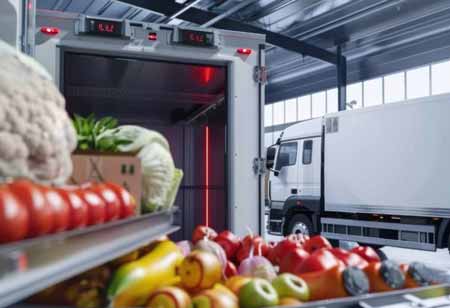Thank you for Subscribing to Food Business Review Weekly Brief
- Home
- Topics
- Alternative Proteins and Plant Based Food
- Beer and Wine
- Canned Beverages
- Coffee And Tea
- Food and Beverage Consulting
- Food and Beverage Financial Service
- Food And Beverages Marketing
- Food Distributors
- Food Ingredients
- Food Sustainability
- Plant Based Food and Beverages
- Seafood Suppliers
- Supplement Manufacturing
- Wine Investment
- News
- Vendor Viewpoint
- CXO Insights
- Conferences
- Newsletter
- CXO Awards
-
Navigating the Complexities of Cold Food Logistics
Cold chain food logistics faces significant challenges in maintaining a consistent, controlled temperature throughout the supply chain to prevent spoilage and ensure food safety.

By
Food Business Review | Friday, September 26, 2025
Stay ahead of the industry with exclusive feature stories on the top companies, expert insights and the latest news delivered straight to your inbox. Subscribe today.

Fremont, CA: Driven by a surge in demand, cold chain food logistics is swiftly evolving and propelled by contemporary technology and sophisticated freight logistics solutions.
Cold chain logistics tends to receive less attention than other forms of food logistics. However, it presents more significant challenges and risks, underscoring the necessity for distributors and all participants in the supply chain to refine their logistics strategies.
Cold chain logistics is a distinct sector within food logistics that aims to ensure the secure transportation of perishable food items. This process guarantees that the products are kept at the appropriate temperature throughout each phase of the supply chain.
This particular logistics sector necessitates meticulous planning, cutting-edge technology, precise management, and some of the most sophisticated packaging and refrigeration solutions available. An in-depth examination reveals the unique challenges faced by this industry, as well as the innovative technologies that are facilitating opportunities for growth on a global scale.
The primary issue in transporting perishable food items is ensuring the safety and quality of the products throughout the shipping process. However, various factors complicate this task within cold chain logistics. They are:
Condensation and Temperature Changes Due to Faulty Equipment:
A prevalent issue encountered is essential equipment failure, even if only briefly. Fluctuations in temperature can lead to risks such as freezer burn, condensation, and damage to products. Sudden equipment malfunctions represent a significant concern within the logistics management framework due to the potential damage that can occur in minutes. The most effective strategy to mitigate these risks is to ensure the availability of backup support to monitor and maintain precise temperature levels consistently. Collaborating with reputable cold chain logistics firms, particularly those equipped with cutting-edge technology for product oversight, can provide valuable assistance.
Human Errors:
Errors in refrigerated logistics frequently stem from human oversight. Only highly skilled professionals should actively manage logistics. Inefficiencies in operations or inadequate equipment management can significantly increase the risk of food product damage. Training on appropriate handling techniques and best practices in cold product management is vital for addressing these issues. Furthermore, technological innovations that automate various tasks and processes may substantially support operational management.
High Costs:
Cold chain logistics requires significant capital investment, which entails substantial expenses for specialized equipment, refrigerated transportation, temperature monitoring systems, and energy usage. The upkeep of cold storage facilities and refrigerated vehicles, particularly those adhering to rigorous standards, can incur considerable costs. These elevated operational expenses may pose challenges for smaller enterprises, hindering their ability to offer competitive pricing, especially in low-margin sectors such as the food industry.






